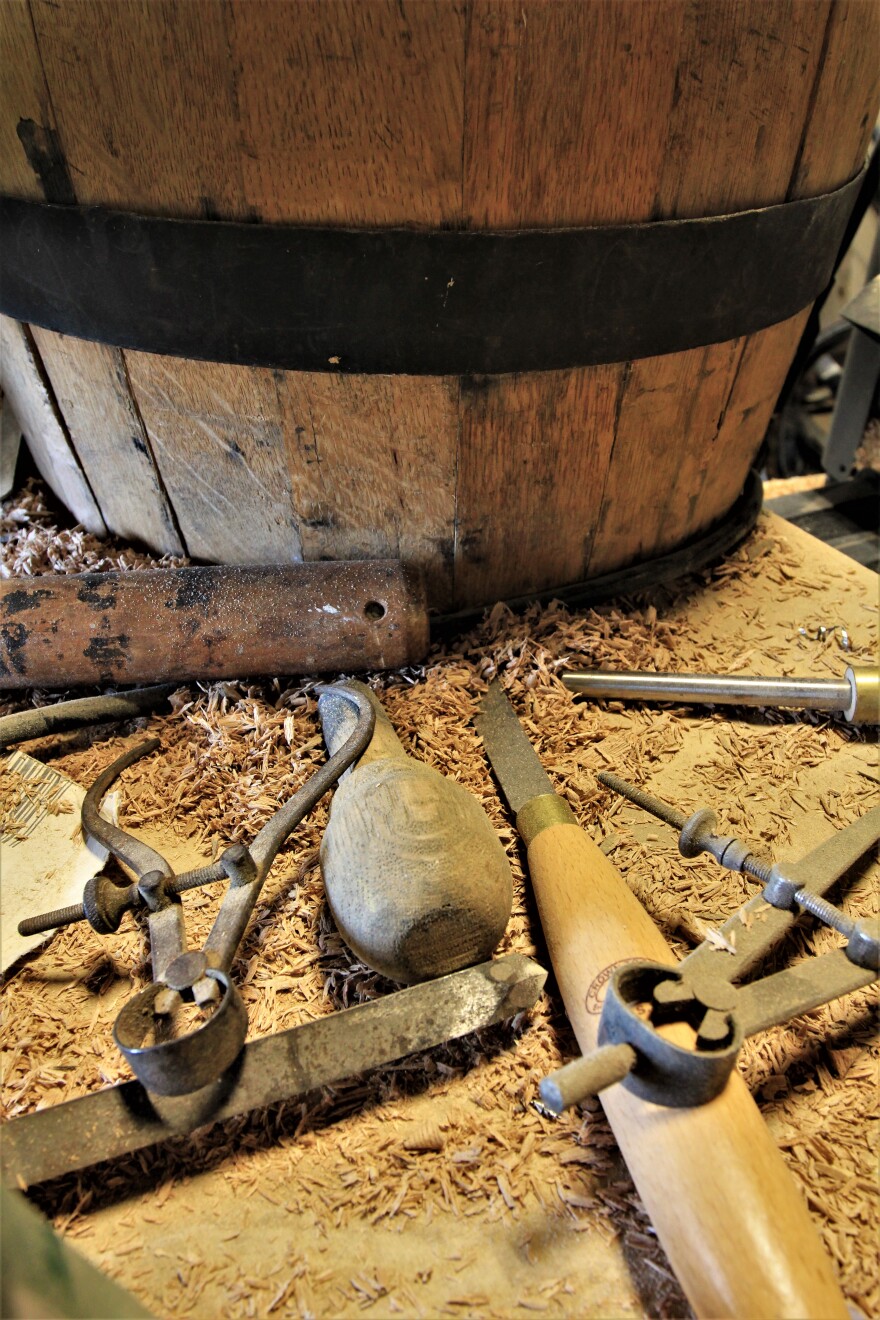These days, a “Cooper” might refer to a brand of cheese or a compact car. But a hundred years ago, a cooper was commonly known as person who built wooden casks to store wine, whiskey or other consumables — and the craft is still alive.
In the next installment of our series “Once Upon a Job,” one cask maker in South Portland says business is good, thanks to a renaissance in craft liquor.
If you like a nip of fine, cask-aged whiskey, part of what you’re enjoying is the flavor of the barrel it came in.
“I use exclusively white oak. It’s watertight, but it also tastes good,” says Ed Lutjens, who handmakes barrels for a number of craft distilleries.
Make a nasty tasting barrel and you’ve spoiled an entire batch of spirits, Lutjens says. He locally sources his white oak from the forests of western Maine, custom mills it and air dries it for at least one year for whiskey casks, and at least three years for wine casks.
Before any liquid goes inside a new oak barrel, Lutjens custom flames the inside for the distiller.

“The sugars in the wood start to caramelize and create all sorts of flavors, and then in addition to the caramelizing of the sugars, the charring of the oak creates that nice smoky flavor that is prized by distillers, whiskey makers and such,” he says.
Lutjens specializes in what’s known as tight coopering or wet coopering — that is, barrels that can hold fluid. There’s also dry coopering for contents such as potatoes. There’s also bucket making, which is a related trade, but Lutjens says he has focused his business around supplying local beer, wine and spirit makers with custom barrels for their handcrafted quaff.
And, by the way, we’ve all been misusing the term “barrel.”
“The barrel actually refers to the volume, not to the shape, not to the thing,” Lutjens says.
He says 36 imperial gallons make up a barrel. A wooden vessel designed to hold food and drink is called a cask. And they come in many more sizes than just “barrel.”
“A pin is a five gallon, a firkin is a ten gallon, which is about this size,” Lutjen says, thumping a modest-size oaken rum cask he’s making for a customer. “A kilderkin is 18, which is half of a barrel size, then a barrel is obviously a 36, there’s hogsheads that are 53-54 gallons.”

And finally the “butt,” which holds about 108 gallons.
“Which is just mammoth,” he says.
As he moves about the shop, the business Lutjens describes sounds very classic, old-timey even, but he’s a young man and he’s only been doing it for about four years. Unlike many other craftspeople, he didn’t apprentice with a master and then take on someone else’s well-established shop.
“I spent the past 20 years or so carpentering my around New England. I did woodworking to make my way through college and just kind of ended up in the woodworking business,” he says.
But Lutjens says he was burning out. The competition was fierce, with fewer people willing to pay for custom woodworks, and he was finding it a chore just to stay afloat. What he needed was a niche.
“As luck would have it, I was doing some piece work for a local distiller, and they said that they were having a really hard time getting barrels, and did I think I could make a barrel,” he says.
He decided to try. But he soon discovered that his options for learning the trade were severely limited.
“Unfortunately, because of the steel industry, because of Prohibition and a couple of world wars, the coopering business pretty much dissolved in the United States,” Lutjens says.

But with the help of some century-old manuals and lot of trial and error, he finally started making barrels that didn’t leak.
“Initially I made a lot of what I call barrel-shaped things that didn’t hold liquid, but eventually I got the knack of it,” Lutjens says.
And he did it using traditional methods, with nothing but hoops and good milling to keep the cask together — no glues or nails of any kind are used.
One of the challenges, he says, was in finding a natural, classic way to seal the groove where the barrel head sits, called the croze. He settled on an old-school wheat paste mixture to act as a sealant.
“Good old King Arthur wheat flour and water, and that just helps to provide a seal for the barrelhead as it sits. There’s a lot of different concoctions that coopers use to seal their crozes, but that’s the one I’ve kind of settled on,” Lutjens says.
He also traveled to Kentucky to spend some time learning more about large-scale barrel making there, where the region’s bourbon and Tennessee whiskey industries have kept a very small pocket of cooperages alive.
These days, Lutjens can make about four or five casks per week by himself, by hand, which he says is a lot less than the local craft distilling industry actually needs. He says he knows of only about nine master coopers left in the entire country, with several of those working for historical re-enactments and living history museums.
Lutjens says he knows of nobody else in Maine who does tight coopering — but he says there’s room in the industry for a lot more.



